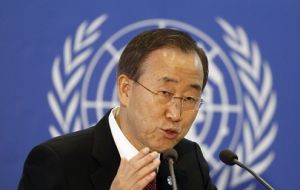MercoPress. South Atlantic News Agency
UN hails progress achieved in reducing damage to the ozone layer
 ”Let us learn from this example and apply its lesson to the urgent task of addressing the climate challenge” said Ban Ki-moon
”Let us learn from this example and apply its lesson to the urgent task of addressing the climate challenge” said Ban Ki-moon United Nations officials hailed on Tuesday the progress made in reducing damage to the ozone layer and the vital role played by one of the most successful environmental treaties in history in phasing out ozone-depleting substances.
“Just over a quarter-century ago, the world united to reverse the rapid depletion of the atmospheric ozone layer, which protects Earth from harmful radiation from space. Today, the ozone layer is well on track to recovery within the next few decades,” Secretary General Ban Ki-moon said in his message for the International Day for the Preservation of the Ozone Layer.
The Day is observed annually on 16 September, the date of the signing of the Montreal Protocol on Substances that Deplete the Ozone Layer, which entered into force in 1989. The Protocol establishes legally binding controls on the national production and consumption of ozone-depleting substances, and enjoys universal ratification by 197 parties.
Recent scientific findings reveal the importance of the Montreal Protocol, said the Secretary-General, noting that without this treaty and associated agreements, atmospheric levels of ozone-depleting substances could have increased ten-fold by 2050.
The Protocol has also significantly contributed to the fight against climate change, as many ozone-depleting substances are powerful greenhouse gases, he added.
“Let us take inspiration from our efforts to preserve the ozone layer. The Montreal Protocol has shown that decisive action by the international community, including the private sector, can achieve transformative results for the common good. Let us learn from this example and apply its lesson to the urgent task of addressing the climate challenge,” Mr. Ban stated.
The ozone layer, a fragile shield of gas, protects the Earth from the harmful portion of the sun’s ultraviolet rays, thus helping to preserve life on the planet. A report released last week by the UN Environment Program (UNEP) and the UN World Meteorological Organization (WMO) found that the ozone layer is on track to recover by the middle of the century.
The assessment by 300 scientists noted that the recovery is attributed to the collective action through the Montreal Protocol, which has led countries to carry out policies to reduce and then phase out their use of ozone-depleting chemicals. At the same time, the report called for the same level of urgency and unity to tackle the challenge of climate change.
Among those celebrating the International Day, whose theme this year is “Ozone Layer Protection: The Mission Goes on,” is the UN Industrial Development Organization (UNIDO) and the other implementing agencies of the Montreal Protocol.
“Today is a great opportunity for us to reflect on the remarkable progress that has been achieved in reducing the damage to the ozone layer. UNIDO is very pleased that our major contribution to the implementation of the Montreal Protocol over the years is now bearing fruit,” said Stephan Sicars, Director of UNIDO’s Montreal Protocol Branch.
Through the promotion of clean production, UNIDO has supported industries to eliminate the use of ozone-depleting substances in manufacturing processes. The agency helps industries to either replace these substances with ozone- and climate-friendly substances, or to redesign their products entirely. UNIDO’s projects and programs have helped a number of countries introduce new technologies that no longer use the harmful substances.
“The Montreal Protocol has significantly reduced the atmospheric abundance of gases, such as chlorofluorocarbons (CFCs) and halons that were once used in products such as refrigerators, spray cans, insulation foam and fire extinguishers,” said Mr. Sicars.
“With full compliance with the Montreal Protocol, the ozone layer is expected to recover to 1980 benchmark levels – the time before significant ozone layer depletion – around the middle of the century. This is great news.”




Top Comments
Disclaimer & comment rules-

-

-

Read all comments“The assessment by 300 scientists noted that the recovery is attributed to the collective action through the Montreal Protocol, which has led countries to carry out policies to reduce and then phase out their use of ozone-depleting chemicals. At the same time, the report called for the same level of urgency and unity to tackle the challenge of climate change.”
Sep 17th, 2014 - 09:25 am 0There never was a problem with the ozone layer, it is changing all the time and the reports of its passing were greatly exaggerated. It is another example of lab experiment extrapolation to the real world. It doesn't pan out because there are so many variables, known and unknown and we don't even know how many unkown variables there are.
The attempt to claim a “success” for “global action” is part of the attempt by the UN to promote even more global governance than we already have.
@ 1 DennisA
Sep 17th, 2014 - 11:50 am 0Damn, you beat me to it.
I quite agree with DennisA that this is just another manufactured crisis. It began with refrigerant producers seeking to get R-12 banned (as lighting manufacturers are doing with incandescent light bulbs) so that they could sell similar (but less effective) products at higher prices. The government officials who were being bribed to effect this change, seeing an opportunity to expand their power by having another area to tax and/or regulate, not only went for it, but took it worldwide.
Sep 17th, 2014 - 12:43 pm 0The ozone destruction theory isn't much different from the theory of man-made climate change. Both are based on tenuous and convoluted propositions, and driven by hype and the fake science of incomplete and inaccurate computer models, relying on unlikely and unproven assumptions.
Commenting for this story is now closed.
If you have a Facebook account, become a fan and comment on our Facebook Page!